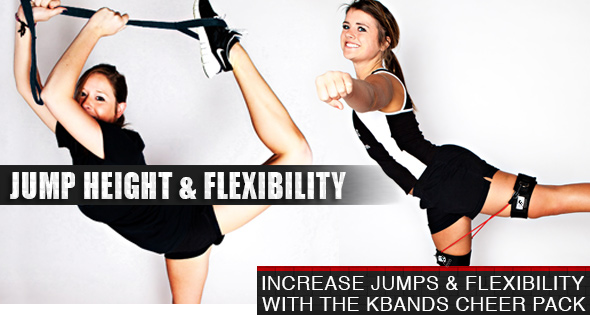Lower Back Exercises For Cheerleaders | Cheer Bands Ballerina RDL
A “Barre” is a temporary or permanent ballerina training tool which is simply a bar which runs parallel to the ground. The barre provides added balance and body control and allows cheerleaders and dancers to become more comfortable while moving through difficult movements. Exercises on the barre are also great for warming up the legs and hips for training.
Cheerleaders can use exercises which are performed on a barre by ballerinas and dancers as leg and lower back exercises. Exercises performed on some sort of permanent or temporary barre provide great advantages for training and increasing flexibility and strength in the low back and legs. The stability provided by the barre allows cheerleaders to focus on going through a proper range of motion with their hips and legs and not focus attention on the balancing portion of the barre exercises and warmups.
Since cheerleading and ballet participants perform many of the same body movements (jumps, lifts, and static holds) cheerleaders can take advantage of the skills which many ballerinas excel at such as balance, fluid movements, and lower body strength.
Performing The Cheer Bands Ballerina RDL With Resistance
When a ballerina performs exercises on the barre they do not use resistance. Cheerleaders often need added strength due to the physicality and explosive movements which are used during cheer routines and competitions. To help cheerleaders build that added strength they will be performing the RDL (romanian dead lift) on their barre with Cheer Bands attached just above their knees. This added resistance will force more muscle activation during the RDL movement and can benefit the hips and glutes when other lower back exercises are performed with Cheer Bands.
As cheerleaders actively move their legs through the RDL range of motion they will feel their glutes and hips contracting and working to continually raise the leg and keep it in line with the rest of the body. The RDL, when performed on a barre with Cheer Resistance Bands, is a great low back exercise which will help cheerleaders be more efficient and explosive when performing cheerleading moves. This is due to the stability which lower back exercises add to the mid section of the human body. When strength is added through low back exercises the strength gained in the lower back also helps to stabilize the abdominal muscles. When both the abdominals and lower back are more stable this provides a more stable and rigid torso which translates into increased vertical jumping, leg and total body stability, balance, and body control.
Build Stability With Cheer Bands Lower Back Exercises
To perform the Cheer Resistance Bands RDL cheerleaders will need a set of Cheer Bands and some sort of “barre” for stability. If cheerleaders have a barre available to them they should utilize that training equipment. Cheerleaders looking for a substitute for a traditional barre can use any stationery object which will help them maintain their balance as they perform a single leg RDL. Stationary items which can be used include: walls. bleachers, stable chairs, or benches.
Once cheerleaders find a proper barre to stabilize them they will attach the Cheer Bands just above their knees and stand in front of their barre. Cheerleaders will perform an RDL by simultaneously lowering the chest toward the ground as they extend and raise one of their legs. Cheerleaders should maintain a straight line running from their heel to the back of their head. Cheerleaders should work for a body position when performing the RDL and should not let the leg sink as the chest is brought parallel to the ground. Cheerleaders should actively focus on squeezing their glutes and raising their heel into the air. When the leg returns to the ground the cheerleader will return their chest and upper body to the starting position before moving into the next Cheer Bands RDL.
Cheerleaders will perform 8-12 repetitions of the RDL on one leg before rotating and performing the same number of repetitions on the opposite leg. Cheerleaders will perform 4-5 resisted sets of the RDL exercise on each leg before removing the Cheer Resistance Bands and perform 1-2 unresisted sets of the RDL exercise on each leg.
When performing the Cheer Bands Ballerina RDL it is important cheerleaders practice good body positioning so they can maximize the effectiveness of the RDL drill. Cheerleaders should keep their hips and shoulders square to the barre in front of them throughout the RDL movement. This will allow all necessary muscles and groups of stabilizing muscles to work through a proper range of motion and will maximize the strength benefits of the resisted RDL drill.
Lower Back Exercises For Strength Training Or Workout Warmup
The Cheer Bands Ballerina RDL exercise is a great cheerleader workout which should be performed at the beginning of a series of lower back exercises. This drill is slow paced and focuses on strengthening the glutes, core, hips, and lower back. Since immediate energy and focus is needed to perform this strength training RDL exercise cheerleaders will want to perform it at the beginning of their training routine. This will ensure cheerleaders muscles are fresh and have enough energy to properly perform the Cheer Bands Ballerina RDL drill.
For this same reason cheerleaders can also utilize this drill as a warmup for the legs and lower back. As stated previously, this RDL drill is a great Cheer Bands drill which takes cheerleaders bodies through a long range of motion. This means that great muscle activation is achieved through the range of motion and the resistance provided by the Cheer Bands. These two characteristics of the Cheer Bands Ballerina RDL Drill make it a fantastic drill to perform regularly at the beginning of training sessions.
Cheerleaders and coaches should move into more active and dynamic cheerleading and lower back exercises. Other great drills and demonstrations can be found in the Cheerleading And Gymnastics Section.

